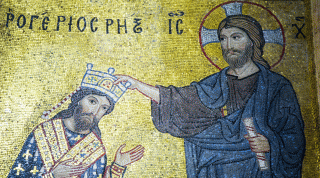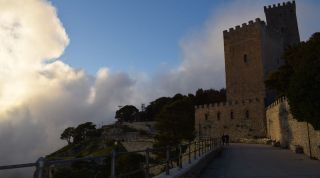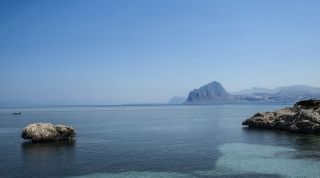Did you know the hidden story behind the building of four emblems of the Western Christianity? Palermo, Cefalù and Monreale Cathedrals, and the church of Santa Maria dell’Ammiraglio (La Martorana).
Were built to praise the exploits of very important people of that time. There’s nothing new under the sun: since the beginning of time, a lot of populations like Egyptians, Mayas, Incas, just to mention a few of them, exalted their sovereigns with Cyclopic buildings. Two of the churches in Palermo were risen to support the desire for fame of a Norman chief and a bishop. It sounds strange but it really happened.
Ruggero d’Altavilla, Norman sovereign, in the 12th century A.D. sponsored the realization of the Palatine Chapel as a private chapel to the Royal Palace. For that reason he actuated a plan of requalification of the Qasr, a stronghold built upon a previous Punic rampart during the Arab domination. With a severe aspect outside, the Palatine chapel has a gold lining inside. Integrated in the political centre of the reign, it shines a light on the social dynamics of that time. We can see the amazing mosaics in it; one of them represents the Virgin Mary giving a blessing for the masterpiece.
There is a similar mosaic image in the Church of Santa Maria dell’Ammiraglio. If you are wondering who the Ammiraglio is, he is Giorgio d’Antiochia (right hand man of Ruggero 2nd), and he wanted the church to be built as his personal tomb. La Martorana follows in part the same style and mode of representation of the Palatine chapel. The admiral, returning from a war of conquest, is represented in front of the Vergin Mary who accepted his prayer. The front of the church has been modified in the baroque style, but just the same travellers from all over the world admired its beauty. Ibn Jubayr, a geographer from al-Andalus, who lived in the 13th century, said that Sicily is “the best monument in the world”.
It is not surprising that an Arabic merchant described a masterpiece of Christianity with such emphasis: in Sicily the Arabic and the Norman dominations proved that cohabitation was not just possible, but also desirable. A very highly mohammedanized city was Cefalù, were, according to a legend, Ruggero 2nd docked after a storm. Because of that, he wanted a church to be built both to be grateful to God and to be buried there with his family. That’s why the Cathedral of Cefalù was built under the rock.
Holy and massive temples outside, inside they are a blaze of colours: small pieces in gold mosaics, placed by the skilled hands of Bizantine and Norman-Arabic artists. Imagine that they used six pieces per cm2 to express the details of Pantocrator Christ at the Cathedral of Monreale, which was built by Guglielmo 2nd. In order to compete with such an amazing masterpiece, Gualtiero Offamilio, bishop of Palermo, sponsored the building of the Cathedral of Palermo. It was built upon a previous mosque converted to the Orthodox church, and as a proof of that use, we can still admire two cufic texts on the columns of the porch.
It is clear that architecture does not have a mere functional scheme, it is a means to express power. In Palermo this is clearly expressed: these buildings show the requirements of a multiform of art in a melting pot of different cultures. Everything was placed under the control of the Norman governance, even the gold mosaics, which were realized with small pieces of history and have many secrets to show you. Don’t miss them!

Roberta Di Rosa
Licensed tour guide
Book a trip or a tour now
Call me or send me an e-mail
+39.329.1263.099info@robertadirosa.com

